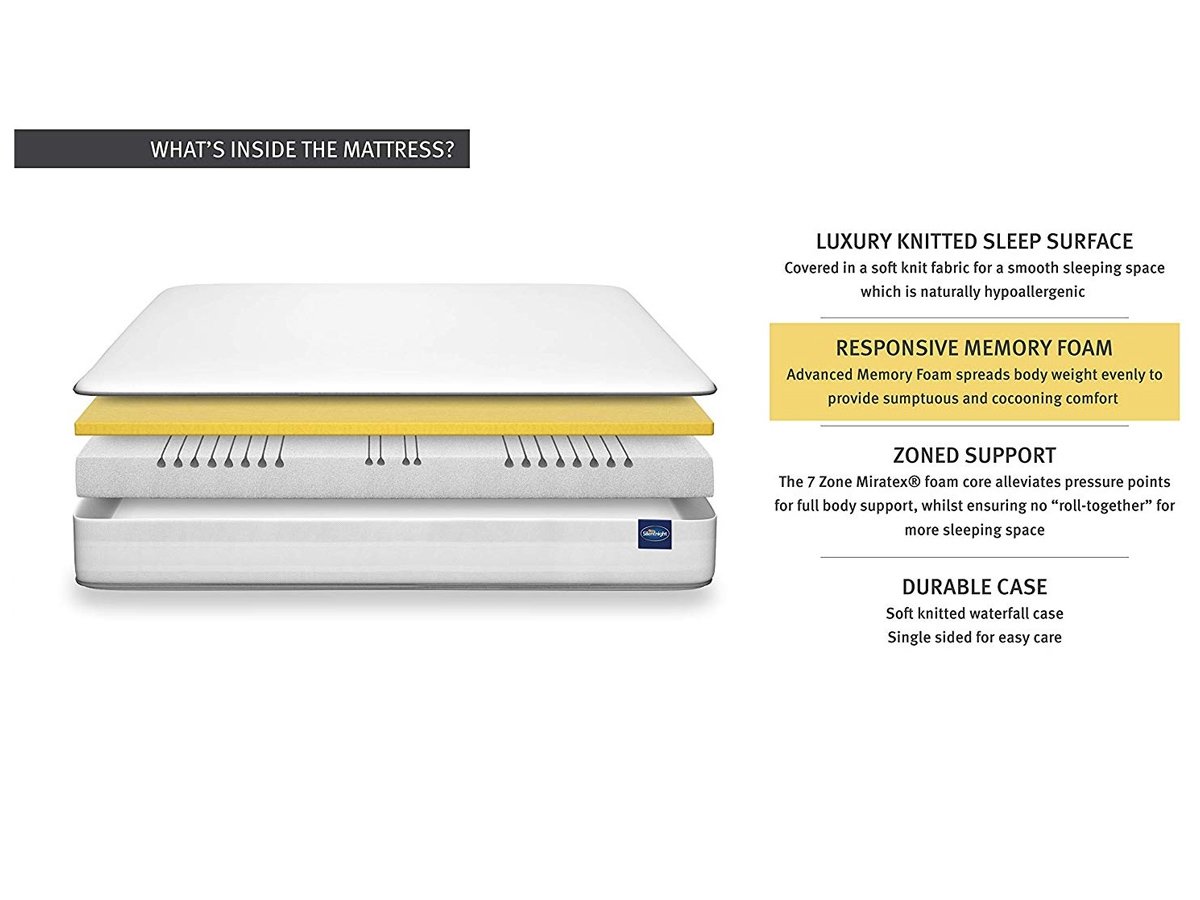Sleep Talk Blog, Bed and Mattress Guides
How to Choose an Adjustable Bed Mattress
Adjustable Bed Mattress
Adjustable beds are a worthwhile comfort upgrade because you can raise and lower the head and foot sections to find a comfortable position. But you need the right kind of mattress for it to work.
The key is finding one that bends as easily as the base moves. That way, it conforms to the different configurations. You also want materials that cushion pressure points, whether flat or propped upright.
Focus on Responsive Foams and Pocketed Spring Mattresses
Memory foam and latex foam mattresses tend to contour well to adjustable frames. These all-foam styles do not contain a rigid inner structure to restrict pliability.
Most feature several foam layers that relieve troublesome areas like the shoulders and hips by cushioning prominently.
The quality foam allows excellent point elasticity, compressing under focused weight and rebounding. This prevents sagging when the bed inclines. Softer foams like memory foam conform closely, while moderately dense latex offers light buoyancy.
Innerspring mattresses can also pair great with adjustable bases, provided they have pocket springs. These fabric sleeves allow each coil to compress independently without dragging down surrounding springs.
Hybrid mattresses combine conforming foam top layers with zoned pocketed coil support cores, providing close-fitting comfort and adaptability. However, these can be a little more expensive. However, they do enhance the overall comfort.

Hybrid mattresses incorporate many technologies and are one of the most advanced mattress types available.
A hybrid mattress combines two or more types of mattress technologies, typically innerspring coils and some comfort layer, such as memory foam, latex, or gel grid.
Hybrid mattresses are designed to provide the benefits of both innerspring and comfort layer materials. Innerspring coils support and bounce, while comfort layers conform to the body's shape and relieve pressure.
Here are some of the benefits of hybrid mattresses:
- Support and comfort: Hybrid mattresses offer the supportive feel of innerspring coils with the pressure-relieving comfort of memory foam or latex.
- Reduced motion transfer: Hybrid mattresses can help reduce motion transfer, making you less likely to feel your partner move in bed.
- Durability: Hybrid mattresses are typically made with high-quality materials and are built to last.
- Versatility: Hybrid mattresses have various firmness levels to suit different sleeping styles.
Here are some things to consider when choosing a hybrid mattress:
- Firmness: Hybrid mattresses come in various levels, from soft to firm. Choose a firmness level that suits your sleeping style and body type.
- Comfort layer type: The type of comfort layer (memory foam, latex, or gel grid) can affect the feel of the mattress. Memory foam conforms to the body's shape, latex is bouncy and supportive, and the gel grid is cooling.
- Thickness: Hybrid mattresses typically range in thickness from 10 to 14 inches. A thicker mattress may provide more support and pressure relief.
A hybrid mattress may be a good option if you're looking for a mattress that supports innerspring coils with memory foam or latex comfort.
Assess Durability and Weight Limits
Keeping durability in mind, adjustable base mechanisms will allow a mattress to flex frequently near the head and foot. Continuous bending can degrade cheaper foams. Higher-density materials resist breakdowns better over time.
The best way to ensure you buy a durable, adjustable mattress is to choose a reputable manufacturer like Recline-a-Bed or Sleepeezee adjustable bed, both of which make their mattresses and beds in the United Kingdom, often with superior materials and manufacturing processes.

Test your adjustable bed mattress at the store
While specs can guide decisions, it's wise to personally assess mattresses by lying on display models with adjustable bases. Have store staff fully incline both the head and foot sections so you can judge flexibility and comfort at steep angles.
Try your regular sleeping positions during the entire movement cycle. Ample contouring and cushioning should remain steady throughout various ergonomic configurations. Pay attention to spinal alignment and whether your hips and shoulders are adequately cradled.
Also, listen for noises like squeaking coils or rubbing internal parts, which signal mattresses lacking optimal flexibility for the adjustable bases on the bed.
All-Foam Adjustable Bed Mattress
If you want to avoid springs, all-foam mattresses contain no metal coils. High-density foams provide comfort and support, as well as good flexibility.

Look for thicker foam layers (4 pounds density and higher) on an adjustable base for the best durability and performance.
Some foam mattresses, like the Silentnight 7 Zone memory, also have zoned support layers to target support and provide even more comfort, particularly beneficial for people with a bad back or aching joints.

Foam mattresses are a popular choice for beds because they offer a variety of benefits, including pressure relief, conforming to your body shape, and motion isolation.
There are two main types of foam mattresses: memory foam and polyfoam.
- Memory foam is known for its ability to contour your body shape, which can help to reduce pressure points and improve sleep quality. However, memory foam can also make you sleep hot, so if you tend to get night sweats, it may not be your best choice.
- Polyfoam is a more traditional type of foam that is firmer than memory foam. It is a good choice for people looking for a supportive mattress that won't sleep hot.
Here are some of the pros and cons of foam mattresses:
Pros
- Pressure relief
- Conforms to your body shape
- Motion isolation
- Variety of firmness levels to choose from
Cons
- Can sleep hot (especially memory foam)
- It may not be as durable as innerspring mattresses.
- It can have a chemical odour when new
If you are considering buying a foam mattress, it is important to research to find the right type of mattress for you. You should also consider your budget and sleeping style.
Adjustable beds offer a variety of benefits and can be a great choice for many people.
Here are some groups who might find adjustable beds particularly useful:
- For people with back pain or other mobility issues, adjusting the bed can help improve spinal alignment, reduce pressure on joints, and make getting in and out of bed easier.
- People with acid reflux or heartburn: Elevating the upper body can help reduce symptoms by keeping stomach acid where it belongs.
- People with sleep apnea: Raising the head of the bed can open up the airways and improve breathing
- People who want to improve their circulation: Elevating the legs can help improve blood flow and reduce swelling
- People who enjoy reading, watching TV, or working in bed: An adjustable bed can provide a more comfortable position for these activities
Healthier people who want a more luxurious sleep experience can also benefit from an adjustable bed.

Recline-A-Bed Pure 2000 Pocket Spring Adjustable Single Bed
Available from Bedstar
Recline-A-Bed
Available from Bedstar

Taking care of your adjustable bed
An adjustable bed can be a great investment in your comfort and sleep quality, but like any other piece of furniture, it needs some TLC to function well for years. Here are some key tips for looking after your adjustable bed:
Consult the Manual: Every adjustable bed is different, so start by carefully reading the manufacturer's instructions. This will provide specific details on weight limits, proper use of the remote, and any recommended maintenance procedures.
Protect Your Mattress: A good quality mattress protector will shield your mattress from spills, dust mites, and allergens, extending its lifespan. Choose a protector that's breathable and specifically designed for adjustable beds.
Keep it Clean: Regularly wipe down the bed frame with a damp cloth. Avoid harsh chemicals or abrasive cleaners that could damage the surface. Vacuum the mattress surface to remove dust and debris, paying attention to crevices where dust bunnies tend to gather.
Rotate the Mattress: While some adjustable bed mattresses may not require flipping, rotating them head-to-foot every few months can help distribute wear and tear more evenly. Check the manufacturer's instructions for your specific mattress.
Watch for Wear and Tear: Give your bed a once-over every few weeks to check for loose screws, bolts, or any signs of damage to the frame or motor. Tighten any loose components and address any issues promptly to prevent further problems.
Don't Overload: Adjustable beds have weight limits, so be mindful of how much weight you put on them. (Average weight limit is 300 to 400 pounds or 21 - 28 stone) Avoid jumping on the bed or placing excessive weight on the edges when sitting.
Use the Right Bedding: Regular bed sheets and comforters might not be ideal for adjustable beds. Look for sheets with stretchy elastic or designed explicitly for adjustable bases to ensure they move smoothly with the adjustments.
Scheduled Maintenance: Some manufacturers recommend professional servicing for your adjustable bed after a certain period. This may involve lubricating moving parts and checking the motor's health.
Following these simple tips ensures your adjustable bed provides years of comfort and optimal performance.

Summing Up
Memory foam and latex mattresses generally work well with adjustable bases. The flexibility of these mattress types allows them to flex with the base as it adjusts and contours to your body.
- Innerspring mattresses can also work, but make sure the coils are individually wrapped. This allows the mattress to flex better with the shape of the adjustable base. Avoid innerspring mattresses with older "Bonnell" style coils. This type of mattress does not provide the correct amount of flexibility for adjustable bed frames.
- Thicker mattresses (14 inches or higher) can sometimes be difficult to adjust correctly, especially for head/foot incline adjustments.
- Pay attention to mattress warranties. Some warranties, especially for innerspring and hybrid mattresses, may require a specific base or frame. Using the incompatible base of an adjustable bed can void certain mattress warranties.
- If the contours of the adjustable base cause comfort issues, adding a mattress topper can help even out the feel.
So, in most cases, you have flexibility when choosing a mattress for an adjustable bed base. Memory foam, latex foam, and newer innerspring styles will adjust well.
Check the warranty terms before buying, and ask the manufacturer for clarification if you are concerned about the compatibility of your chosen mattress.

